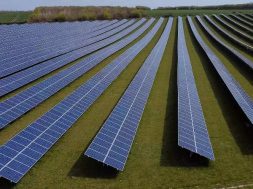
Butterfly Wings May Have Just Inspired Us To Build More Efficient Solar Panels Than Ever Before
As scientists attempt to improve how we can capture and store renewable energy, they may have chanced upon a unique solution straight from nature’s book.
Scientists from the California Institute of Technology have developed a new kind of solar panel, designed to mimic the wings of a butterfly. And this panel is twice as efficient as current solar panels.
In usual designs, solar panels are made up of thick solar cells positioned at an angle to capture the most amount of sunlight as the sun shifts through the day. Thinner solar cells instead, only nanometres thick, are promising because they’re cheaper and lighter. However, they’re also less efficient, so we usually only see them in small devices like watches and calculators.
The team, in an attempt to make these thinner solar cells more efficient, studied the black wings of the rose butterfly native to Southeast Asia. Being a cold-blooded creature, it’s black wings have evolved to be very good at absorbing sunlight and keeping the butterfly warm. The research team, led by bioengineer Radwanus Siddique, looked at the butterfly’s wings under a microscope and recreated a 3D model of the nanostructures they saw.
Built from tiny scales, the butterfly’s wings are covered in randomly spaced holes less than 0.0001 of a millimetre wide. These holes help scatter the light hitting the wing, letting it better absorb the incoming heat. The team then designed a solar panel and recreated the wing structure (but not shape) using thin sheets hydrogenated amorphous silicon with the same types of holes.
Because the design is easily implemented and scaled, scientists can easily design large-scale solar panels for industrial and utility use which will be much more efficient at capturing solar energy.
Source: indiatimes
Related posts:
- Amtech Announces $22 Million in New Solar Orders in Fiscal Q1 Includes Significant Order for High Throughput Diffusion and PECVD Systems
- PERC cells: production costs down, efficiency up
- Department of Energy Announces Prize Competition to Accelerate U.S.-Based Solar Manufacturing
- Heraeus Photovoltaics and Cell Engineering announce partnership to bring high-yield LECO technology and metallization pastes to market
















